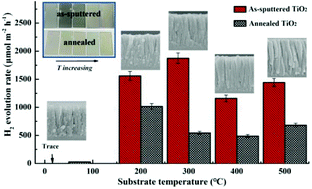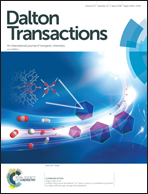One-step synthesis of nonstoichiometric TiO2 nanorod films for enhanced photocatalytic H2 evolution†
Abstract
The realization of one-dimensional nanostructures or Ti3+ self-doping in TiO2 photocatalysts has proven to be an effective approach for significantly improving their photocatalytic performance. Herein, a series of nonstoichiometric anatase TiO2 nanorod films were deposited at 50–500 °C by a facile one-step magnetron sputtering method. The correlation between the microstructures and the photocatalytic H2 production abilities of the films was studied. It is found that, by increasing the deposition temperature, the as-sputtered TiO2 grains transformed from quasi-spherical to rod-like structures while the concentration of the Ti3+ species decreased gradually. Thus, by virtue of the collaboration between nanostructure engineering and defect engineering, the sample deposited at 300 °C showed a maximum H2 generation rate of 1874 μmol m−2 h−1, which was about 134 times higher than that of a Degussa P25 powder film (14 μmol m−2 h−1). Furthermore, the stoichiometric TiO2 shell formed on the surface of TiO2 nanograins protected the defective TiO2−x core from further oxidation, resulting in an excellent photocatalytic stability of the films. The possible film growth and photocatalytic reaction mechanisms over the Ti3+ doped TiO2 nanorod films have been investigated. Our work provides a facile route to fabricating a high-efficiency defect-based TiO2 or other transition metal oxide nanostructures with a controlled morphology for solar energy conversion.



 Please wait while we load your content...
Please wait while we load your content...